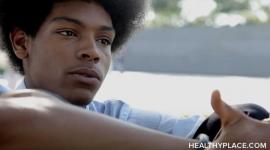My Bipolar Story
A woman shares her story of life with bipolar disorder, being homeless, yet still having hope that things will improve.
Personal Stories on Living with Bipolar Disorder
Manic Depressive, Homeless, and Hopeful
 Looking back, it's hard to believe that it took over 40 years before I was diagnosed bipolar (manic depressive). During my childhood, I went back and forth between A+ student and "underachiever." As an adult, I went back and forth between workaholic and drifting vaguely between jobs, couch-surfing.
Looking back, it's hard to believe that it took over 40 years before I was diagnosed bipolar (manic depressive). During my childhood, I went back and forth between A+ student and "underachiever." As an adult, I went back and forth between workaholic and drifting vaguely between jobs, couch-surfing.
In 1994, while I was staying with my sister "between jobs," she cleared up some of my misunderstanding about manic depression (which had come to be called bipolar disorder) and I saw a psychiatrist, who made the diagnosis official. I was afraid of medication, however. I thought that by knowing what was going on I could control my cycles better — by diet, exercise, and regularized sleep.
In 1995, though, I slid into a depression with no manias. It went on and on. I was staying with a friend who had a home business, and let me work in his home office and sleep on his couch. I became less and less effective, more and more foggy, confused and lethargic. Eventually he hired someone else for the office work, but he let me stay with him until I "got better" and found other work.
In October, he told me that a family member was coming for a visit and he needed the couch. I pulled some energy up, put on a bright face, and told him I'd found a job and an apartment, I'd be just fine.
I spent what money I had left on a night at the YWCA. The next night, I rode the bus out to the airport — I'd heard that people slept in the transit lounge at the airport. When I got their, there were two older white men with twine-wrapped boxes on old handcarts, three older black men with the same sort of "luggage," and two white women with newish-looking luggage, both stretched out asleep. Everyone had what I've come to call "the pavement look" on their face. Several hours later, everybody was still there. Eventually, I went to sleep. At four in the morning, two airport security men came around and started asking the black men to show their tickets. "If you need shelter," they said, "we can get you to a shelter."
I thought we were all busted. But after rousting the black guys, the security folks moved on. They never asked any of the rest of us to show a ticket. I doubt that any of us could have.
The next day, I spent several hours wandering Capitol Hill, looking for a sign in a window saying, "Desperately wanted: One manic-depressive computer programmer, to start immediately." I didn't find one.
Finally I stopped on a street corner and said too myself, "This is it. I'm 45 years old, broke, unemployed, homeless, sick, manic depressive, my hair's a mess, I have bad teeth, I'm overweight, and my tits hang down to my navel. I need help."
Suddenly I felt a great sense of peace. I walked into a low-income apartment building and said, for the first time, "I'm homeless and I think I'm manic depressive. Where can I go?"
They directed me down to Angeline's day center in downtown Seattle. When I walked in and introduced myself to the staff at the front desk, they had a pile of reference material for me, God bless 'em. Shelters, housing programs, meal programs, food banks, where to find free clothes, even how to get a new ID card. The packet of papers seemed an inch thick. And they pointed to a free phone I could use.
I was in depression! I made two calls, got answering machines, left messages — then went to a couch and sat down for the rest of the day.
Angeline's closed at 5:30 pm. The staff asked one of the other women using the shelter to show me the way to the evening shelter, Noel House. It was two and a half blocks away. They knew I might not make it on my own.
When you arrived at Noel House they added your name at the bottom of a list. The top forty women on the list had beds at Noel House. The rest of us were referred out to one of a network of volunteer shelters. As one of the women in beds moved on, one of the other women on the list would move up.
All of us ate together and socialized until about 7:30. Then vans came around; each van took eight to ten women to a different church or school. There we would get out with a couple of bags of blankets, and go in; to a school gym, or a church basement, or some other empty area. The volunteers would unlock a storage room where mats were kept. We'd each lay out a mat and two blankets. Usually there was some kind of juice, hot cocoa, cookies. At ten the lights were turned off. At six in the morning the lights went on again, and we got up, put the mats away, bagged the blankets, and cleaned the area, including the restrooms we'd used. By 7AM, the van arrived to pick us up, drive us downtown, and let us off in front of Angeline's, which opened at 7:30 AM.
I was extremely fortunate. That first night at Noel was one of the nights that a mental health outreach worker came to the shelter. Instead of waiting in an office for people to find their way in, these workers went out to places where homeless people were, including streets and underpasses, found people in need of help, built up a relationship with them, and got them into services and housing.
I was easy. I was ready for help. Medication was still scary, but the alternative was scarier. During my wandering on Capitol Hill that day I'd even found a free medical clinic, and I had a prescription for Lithium in my pocket. I didn't have the money to get it filled, though.
Debbie Shaw got me my Lithium. I took my first dose just before dinner the next night. Halfway through the meal, I noticed the color of the walls, and I could taste the food. The next day I was able to complete forms for food stamps and disability.
A few days later, I helped get another woman, physically disabled, into the van. When we got to the shelter, I showed the women who were new where the mats were, and the restrooms, and explained that we open up these bags here, see, and everyone gets two blankets... Suddenly everyone was crowded around me, looking to me to tell them what to do. I felt panicky inside, but I took a deep breath and went on explaining.
After about a week, I couldn't stand to be "looked after" any more. I noticed a sign on the wall of Noel House announcing a "self-managed shelter." The next day I went down the street to the offices of SHARE (Seattle Housing and Resource Effort) and screened in to CCS — the shelter hosted in the cafeteria of the Catholic Community Services center. I was given a bus ticket and told that I could arrive any time from 9 pm to 10 pm.
Usually most of us would arrive at 9. There was a public library across the street, in fact, so several of us would go to the library in the evening and go across to the shelter when the library closed. One member of the shelter who had been designated for the duty had picked up the keys, and opened the storage shed we were allowed to use, and the door of the cafeteria. We all hauled in mats and blankets, then whatever personal belongings we had stored. This was a co-ed shelter, with a maximum capacity of 30. The women (there were never more than half a dozen, and sometimes only me) would set up in one corner of the room, and the men would set up elsewhere, with some clear space between. There were a couple of married couples; even they had to sleep separated, the man in the men's area, the woman in the women's area.
Our conditions were luxurious compared to most shelters. Besides being allowed to store personal belongings in the storage shed, we were allowed use of the coffee machines, the microwave, and even the refrigerator. Sometimes we would have a group meal; most of the time, everyone cooked personal food. We could even go back and forth to a nearby store, until lights out. And we had a TV!
The group at this shelter, at this time, included a lot of readers, Star Trek fans, and chess players. We would have a very companionable evening, then lights out at 10:30. At six the lights went back on, and the Coordinator (shelter member elected new each week) made sure everyone got up and did designated chores. We got everything put away, cleaned the area, and set up the cafeteria tables for the day. We each got two bus tickets: one to get downtown for the day, one to get back to shelter that night. The designated person took the keys, leftover tickets, and paperwork to the office; the rest of us went our various ways for the day.
Some people worked. One young black man got up at 4 a.m. every morning, ironed his clothes in the dark, and walked a mile and a half to catch the bus to work. One man — a carpenter with a philosophy degree — sometimes got temporary jobs out of town. We were allowed to spend up to two nights out a week and still have our mat guaranteed there when we came back. Any more than that, you lost your spot and had to screen in again.
One man, a lab technician who had a back injury, was going to a Vocational Rehabilitation program. Several worked day labor. Some had medical appointments almost every day; others went to school. SHARE relies heavily on volunteers, and there was always something to do in the office, or blanket-washing, or cooking. Several of us spent time each day at StreetLife Gallery.
I had discovered this while walking to Noel House — it was in the same block. StreetLife Gallery was started by a homeless man, provided space and utilities for free from the Archdiocesan Housing Authority, and provided work and display space, and materials, for homeless and low-income people who wanted to make art. You kept 100% of any sales you made. the Gallery was self-managed by the people who used it.
I began writing poems again. One of the men at the Gallery, Wes Browning, was on the editorial committee of the Real Change homeless newspaper. He invited me to join the EC. Each month we read a new batch of submissions, including a lot of writing by homeless people that was good stuff, but needed work before being publishable. I worked witha couple of people one-on-one, but I didn't have enough energy to do a lot of that. I thought it would be more effective to have a workshop where everyone gave each other feedback. Real Change let me use space in their office for meetings — and their paper and pens and computers and coffee. That was the beginning of StreetWrites.
In the meantime, I was taking part in almost anything that came up at SHARE — neighborhood meetings to open new shelters, meetings with city officials about funding, our weekly shelter organizing meeting and the the weekly all-shelter organizing meeting. There was a group of women within SHARE, called WHEEL, who focused on safety and shelter for women, and I got involved in that, too. WHEEL initiated a project called the Homeless Women's Network, in partnership with a number of professional women, to increase the use of computers by homeless and low-income women and youth. The group decided that since I had the most experience with computers, I would teach women to use the Internet.
I was scared stiff. I didn't know how to use the Internet myself! I hadn't done anything technical in over a year! I had just come out of depression! I was going to fail and then I would die! But I firmed up my jaw and went down the local Cyber Cafe, Speakeasy, that provided Internet accounts for $10 a month. And, as you can see, I took to it. :-)
I began telling everyone I met, "Do you have email? Do you want email? I can get you email." I would take them in to Real Change and show them how to sign up on Yahoo or Hotmail or Lycos. Real Change added a second Internet line. Eventually the traffic got so heavy they added a whole computer workshop.
I got into housing in January 1996. I stayed on disability. I do a lot of volunteer work — I've only covered part of it here, I cover more in other places — but I still have cycles of depression, even on medication. The people I work with are supportive, even when I get erratic. A corporate computer programming department wouldn't — couldn't — be. This year, 2002, I was finally approved for Social Security.
I've had problems with depression again this year (2002). My bipolar disorder, my physical heath, and my allergies are all bound together; any one of them gets bad and it starts a spiral effect. This year was an early and heavy hay-fever season followed by an early and heavy flu season. I've been slowed down to about quarter speed since September. I thought for awhile I had something awful, but according to, the doctor I'm just debilitated, my resistance is low, so I keep getting the flu every time it mutates. Which makes the depression worse. I have friends with cancer who are more productive than I am right now.
But I have faith. I know I will survive, and I will eventually get better. I always do. In the meantime, I do what I can. I did the layout on the new WHEEL poetry book. I helped with the campaign to get the King County Winter Response Shelter opened this year, and the campaign to get critical human services in Seattle funded. One of the things I'm doing is organizing all my material about homelessness to make a website that's helpful.
My hope is that someone has learned or benefited from reading my story.
Ed. note: This article is one in a series of personal perspectives on living with bipolar disorder.
next: Dump the Stigma and Focus on Recovery
~ bipolar disorder library
~ all bipolar disorder articles
APA Reference
Staff, H.
(2008, December 18). My Bipolar Story, HealthyPlace. Retrieved
on 2024, June 20 from https://www.healthyplace.com/bipolar-disorder/articles/manic-depressive-homeless-and-hopeful



